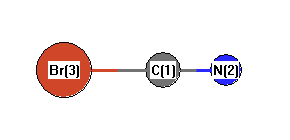Vibrational Frequencies calculated at MP2=FULL/aug-cc-pVDZ
| Mode Number |
Symmetry |
Frequency
(cm-1) |
Scaled Frequency
(cm-1) |
IR Intensities
(km mol-1) |
Raman Act
(Å4/u) |
Dep P |
Dep U |
|---|
| 1 |
Σ |
2084 |
2020 |
3.75 |
75.80 |
0.25 |
0.40 |
| 2 |
Σ |
599 |
580 |
2.00 |
6.71 |
0.09 |
0.17 |
| 3 |
Π |
348 |
337 |
1.52 |
0.65 |
0.75 |
0.86 |
| 3 |
Π |
348 |
337 |
1.52 |
0.65 |
0.75 |
0.86 |
Unscaled Zero Point Vibrational Energy (zpe) 1688.9 cm
-1
Scaled (by 0.9692) Zero Point Vibrational Energy (zpe) 1636.8 cm
-1
See section
III.C.1 List or set vibrational scaling factors
to change the scale factors used here.
See section
III.C.2
Calculate a vibrational scaling factor for a given set of molecules
to determine the least squares best scaling factor.
